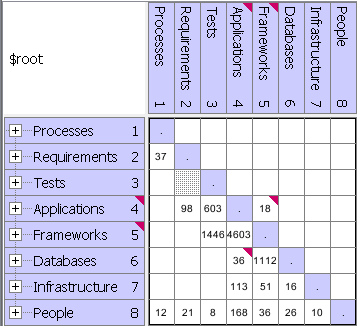Modeling Complex Systems#
Dependency Structure Matrix (DSM) techniques support the management of complexity by focusing attention on the elements of a complex system and how they are related to each other. DSM-based techniques have proven to be very valuable in understanding, designing and optimizing complex systems, including product architectures, organizations and processes.

Systems Analysis Approach#
Lattix Architect can be used to analyze a complex system or process. This process typically requires the following steps. These steps may have to iterated.
1. Identify the Problem: Identify the problem to be solved. Here are some possible reasons:
Provide visibility of the complex system to the entire team.
Analyze and understand the impact of changing one or more elements.
Redesign the complex system to make it more modular and assign responsibility for maintainability.
Measure and track the evolution of the system over time.
2. Design a Taxonomy: List the various elements of the complex system. This process is actually a design step, because the choice of elements is often dependent on the problem to be solved. It also means excluding elements that are irrelevant. Here are some examples of elements in a taxonomy:
List of the processes.
List of key systems.
List of key deliverables/outputs.
3. Extract Dependencies: In this step you specify dependencies between various elements. The process can be automatic or manual. Here is an example of dependencies:
Dependencies can be automatically extracted for many software artifacts such as code, diagrams, CAD elements etc.
Process and subject matter experts can provide dependency information in a spreadsheet form.
Custom scripts can be written to extract dependencies from files etc.
Lattix Architect provides tools for all of these various steps. We also provide consulting services to help you during knowledge acquisition, systems analysis, and for deployment.
